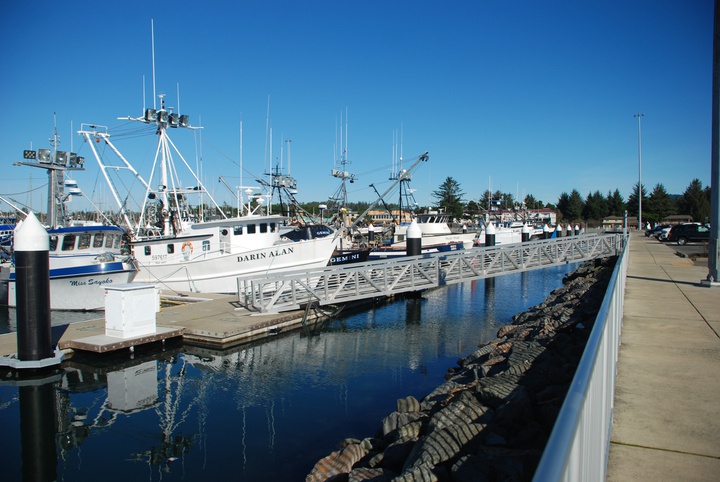Jessica Cejnar Andrews / Tuesday, Dec. 6, 2022 @ 5:35 p.m.
Crescent City Harbormaster Says It's Four Months Away From Permit That'll Lead to Disposal of 95,000 Cubic Yards of Dredge Material

Crescent City Harbormaster Tim Petrick said the inner boat basin will soon be due for dredging. | File photo: Jessica C. Andrews
Previously:
###
It’ll likely take another four months for the Crescent City Harbor District to get permission to remove the 95,000 cubic yards of dredge material it’s stored for nearly a decade, but that doesn’t mean it’ll be gone immediately, Harbormaster Tim Petrick said.
“That’s still going to take probably most of the year to even get the Army Corps to mobilize to take their 52,000 (cubic yards),” Petrick told commissioners Tuesday. “So the dredge ponds are still probably, I would say, a year and a half from being available for filling.”
Petrick said he anticipates the State Water Quality Control Board to approve a beneficial use permit for the harbor this week. The next part in the process, he said, is an application for a permit waiver.
The Crescent City Harbor District recently submitted an engineering sample of the material to the Water Quality Control Board and still needs to meet CEQA and NEPA requirements, which will take about two months, Petrick said. It’ll then take another two months roughly for the Water Board to finally approve the permit waiver, he said.
Finding a viable disposal site for the 10-years of accumulated fine silt and soil in its dredge ponds has been a regular point of contention at Crescent City Harbor District meetings for about a year and a half. The U.S. Army Corps of Engineers has accepted responsibility for about 60,000-90,000 cubic yards of that material.
Removing the material is the only obstacle that stands in the way of the port being able to resume dredging in the inner and outer boat basins, including the docks around Fashion Blacksmith. Since the Water Quality Control Board classifies it as solid waste, the silt and soil can’t be deposited in a regular landfill.
On Tuesday, Petrick said he’s also working on obtaining an emergency dredge permit to bring a diver to dredge around Fashion Blacksmith. There’s also the regular 10-year permit that’s “just pending a disposal site,” Petrick said.
He told commissioners that they also need to think about getting the inner boat basin dredged since “it’s due anyway.”
“What we can dredge is pretty much all the fine tailings, and it either needs to go to our ponds or to HOODs or another offshore designated site for that,” Petrick said, referring to the Humboldt Open Ocean Disposal Site near Eureka. “The Army Corps, 2-3rds of what they dredge is coarse sand and on a case-by-case basis, they can discharge that at Whaler Island.”
Members of the public and Crescent City Harbor Commissioners also brought up the possibility of sediment impacting the harbor following the removal of the Klamath River dams.
Commissioner Rick Shepherd said if the dams do have a negative impact, “all these problems we’re having with the Water Board and everything else will go away in an emergency situation. That’s what happened when the tsunami hit.”
Commissioner Brian Stone referred to a memorandum of understanding he and his colleagues signed last year, which included Del Norte County and the Klamath River Renewal Corporation, the nonprofit tasked with removing the dams.
The MOU ensures the harbor and county can recover potential damages to the port and the fishing industry that occur as a result of dam removal and reservoir drawdown.
“If this shows up that it’s silting up the harbor, they’re going to be responsible for it and they’re going to have to pay for all this,” Stone said, referring to KRRC.
The largest dam removal project in history cleared its final regulatory hurdle last month when the Federal Energy Regulatory Commission approved KRRC’s application to surrender the dams’ operating license.
CLICK TO MANAGE